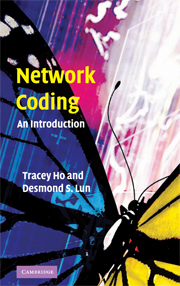2 - Lossless Multicast Network Coding
Published online by Cambridge University Press: 06 July 2010
Summary
Multicast refers to the case where the same information is transmitted to multiple sink nodes. The first application of network coding to be discovered was that network coding allows the maximum possible multicast rate to be achieved in a noise–free, or lossless, network. Clearly, this rate can be no more than the capacity between the source and each sink individually. As we will see, network coding allows joint use of network resources by multiple sink nodes, so that any rate possible for all sinks individually is simultaneously achievable for all sinks together.
NOTATIONAL CONVENTIONS
We denote matrices with bold uppercase letters and vectors with bold lowercase letters. All vectors are row vectors unless indicated otherwise with a subscript T. We denote by [x, y] the concatenation of two row vectors x and y. For any vector (or matrix) whose entries (rows/columns) are indexed by the arcs of a network, we assume a consistent ordering of the vector entries (matrix rows/columns) corresponding to a topological ordering of the arcs.
BASIC NETWORK MODEL AND MULTICAST NETWORK CODING PROBLEM FORMULATION
Leaving aside for a start the complexities of real packet networks, we consider a very simple network model and problem formulation, widely used in the network coding literature, to gain some fundamental insights and develop some basic results. We will later apply these insights and results to more complex network models.
- Type
- Chapter
- Information
- Network CodingAn Introduction, pp. 13 - 48Publisher: Cambridge University PressPrint publication year: 2008
- 1
- Cited by



